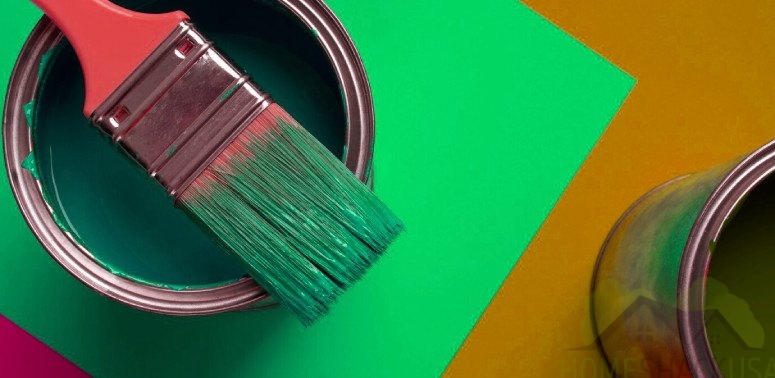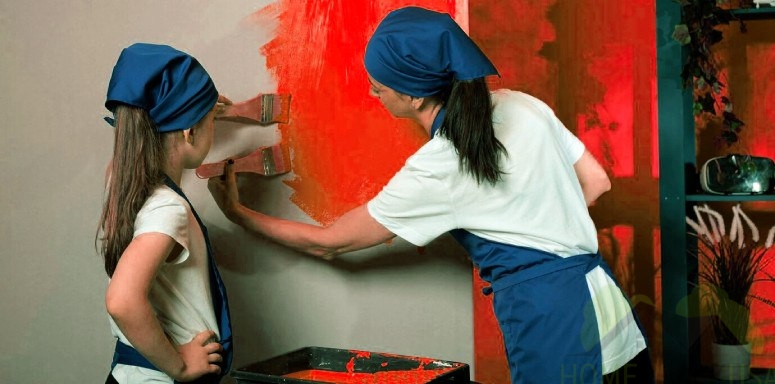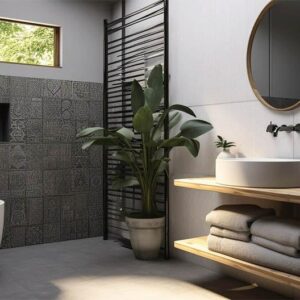Choosing the right paint colors for your home can transform not just your space, but also your mood and overall experience.
With so many options available, understanding the basics of color theory—like primary, secondary, and tertiary colors—plays a crucial role in making informed decisions.
The type of paint finish can greatly affect the final look. This guide will help you choose the perfect colors for different rooms, along with tips to ensure your selections harmonize beautifully.
Why is choosing the right paint color for your home important?
Choosing the right paint color for your home is not just a matter of aesthetics; it significantly influences the atmosphere and mood of each room. The colors you select can evoke emotions, create a sense of flow, and even affect how spacious or cozy a space feels.
A thoughtfully chosen palette can enhance your home’s design, ensure consistency across different rooms, and serve as a foundation for complementary furnishings and accessories.
Furthermore, understanding the psychology behind colors can help you make informed decisions that align with your personal style and the intended function of each space.
Understanding color theory
Understanding color theory is essential for anyone looking to create a harmonious and visually appealing environment in their home.
This foundational knowledge encompasses the relationships between colors, including how shades and hues can interact with one another, as well as the significance of undertones in achieving balance.
Familiarizing yourself with concepts such as complementary colors and various tints can unlock endless possibilities when designing your palette, ultimately enhancing the overall aesthetic and functionality of your space.
What are the primary colors?
Primary colors are the fundamental colors from which all other hues are created, including red, blue, and yellow. These colors serve as the base for developing secondary and tertiary colors and play a critical role in any design scheme, especially when considering how they can be combined to form a vibrant palette for your home.
When incorporated thoughtfully, these primary colors can transform a dull space into a lively environment that resonates with energy and creativity.
For instance, a red accent wall in a living room can evoke warmth and excitement, making it an inviting social hub.
In contrast, using soft shades of blue in a bedroom can create a serene atmosphere, promoting relaxation and tranquility.
Conversely, a splash of yellow in a kitchen, such as through accessories or painted cabinets, can introduce a cheerful vibe that stimulates appetite and conversation.
The strategic use of these bold colors can significantly influence the mood and functionality of each room in your home.
What are the secondary colors?

Secondary colors are created by mixing two primary colors, resulting in hues like green, orange, and purple.
Understanding these colors and their applications can enhance your home design by introducing richer tones and adding depth to your palette, making spaces feel more inviting and cohesive.
When thoughtfully integrated, these shades not only enrich the visual landscape but also evoke emotional responses that define the atmosphere of a room.
For instance, pairing a vibrant orange with a deep blue can create a striking balance, fostering energy while simultaneously radiating calmness.
- This harmony aids in establishing a flow throughout your space;
- Each secondary hue contributes uniquely, transforming areas into cozy retreats or vibrant gathering spots.
Consider how the right combinations can influence moods, making an environment feel either lively or serene, illustrating how essential color choices are in achieving the desired emotional ambiance.
What are the tertiary colors?
Tertiary colors are the result of mixing a primary color with a secondary color, resulting in a variety of complex hues that can enhance your color palette.
These colors, which include shades like red-orange and blue-green, can add depth and dimension to rooms, creating a more dynamic and engaging visual experience in your home.
By incorporating tertiary colors alongside neutrals, such as beige or gray, one can achieve a harmonious balance that feels both inviting and stylish. These accents can complement textures found in fabrics, furniture, and decor, thereby enriching the overall aesthetic.
It’s essential to consider the warmth and tones of these hues because they can dictate the mood of a room.
- For instance, a soft blue-green can invigorate a space while remaining subtle;
- A vibrant red-orange can serve as a focal point, attracting the eye and sparking interest.
The combination of tertiary colors with neutrals creates a seamless flow throughout your design, making it feel cohesive and thoughtfully curated.
What are the different types of paint finishes?
The type of paint finish you choose can greatly impact the appearance and durability of your walls, making it an important consideration in your home design.
Each finish, ranging from matte to high-gloss, offers different levels of sheen, texture, and functionality. Matte finishes provide a soft and elegant look, while satin finishes offer a slight sheen that enhances durability.
Semi-gloss and high-gloss finishes are perfect for areas that require more washability and reflectiveness, such as trim and cabinetry. Understanding these options can help you make informed decisions that enhance the overall atmosphere and style of your space.
What is matte finish?

A matte finish is a non-reflective paint option that provides a soft, elegant aesthetic to walls, making it an ideal choice for creating a calm and cozy atmosphere in various rooms.
This type of finish is particularly popular for living areas and bedrooms, where a warm, inviting environment is desired.
Plus its aesthetic appeal, many find that this finish can also be quite complementary to neutral hues, enhancing the overall design without overwhelming the senses.
For homeowners seeking to integrate matte finishes into their space, it’s important to consider both the benefits and drawbacks of this paint style.
- Benefits – It effectively hides imperfections, offering a more uniform look and is renowned for its depth of color.
- Drawbacks – It can be susceptible to stains and may require careful touch-ups, as cleaning can sometimes prove challenging.
Despite these limitations, the interplay of matte walls with other design elements can create a sophisticated flair that showcases a well-thought-out aesthetic.
What is satin finish?
Satin finish paint has a subtle sheen that strikes a balance between matte and glossy, offering both aesthetic appeal and durability.
This finish is ideal for high-traffic areas, such as kitchens and bathrooms, where moisture resistance and ease of cleaning are essential without sacrificing visual warmth.
Beyond its practical benefits, the satin finish serves as a versatile choice that effortlessly enhances a variety of design themes, blending seamlessly with both contemporary and traditional styles.
Its ability to reflect light can create an inviting ambiance, particularly in spaces where natural light is abundant.
These reflective qualities not only brighten up a room but also highlight the textural details in furnishings or architectural elements, allowing for a more dynamic visual experience.
- Maintenance is straightforward; a simple wipe with a damp cloth can suffice to maintain its fresh look;
- This makes it an appealing option for homeowners who want both beauty and functionality.
As a result, incorporating satin finishes in bedrooms, living rooms, and entryways can yield a harmonious blend of style and practicality, contributing to a cohesive home environment.
What is semi-gloss finish?
A semi-gloss finish provides a noticeable sheen, making it a popular choice for areas requiring durability and washability, such as trims, moldings, and kitchen cabinets.
This particular sheen strikes a balance between flat and high-gloss, offering remarkable reflection properties that enhance the tones of bold colors, resulting in a vivid visual appeal.
When applied thoughtfully, a semi-gloss finish not only draws attention to the architectural details but also complements vibrant hues, breathing life into any space.
It is exceptionally easy to maintain, making it an ideal choice for high-traffic areas where cleaning is frequent. Its resilience against stains and scuffs ensures that these surfaces remain attractive over time.
Incorporating this finish allows homeowners and designers alike to enjoy a blend of elegance and practicality.
Here are some key advantages:
- Durable and easy to clean;
- Enhances bold colors and architectural features;
- Resistant to moisture, making it suitable for kitchens and bathrooms;
- Offers a sophisticated, moderately shiny look.
What is high-gloss finish?

High-gloss finish paint creates a dramatic, reflective surface that can make colors appear more vibrant and bold, making it an ideal choice for accent walls and furniture pieces.
This finish is highly durable and can withstand cleaning, making it suitable for areas prone to wear and tear.
Plus its resilience, high-gloss finishes significantly contribute to the overall atmosphere of a room. By enhancing the interplay of light and color, they invite a sense of depth and richness that elevates ordinary spaces into extraordinary environments.
When exploring color palettes that incorporate:
- Rich jewel tones;
- Bright hues;
- Unexpected contrasts.
the reflective quality of high-gloss surfaces can accentuate these choices, making them even more eye-catching.
- Consider using high-gloss finishes in living rooms to create a vibrant focal point or as a backdrop for artwork;
- In kitchens, cabinets coated with glossy paint not only simplify maintenance but also visually enlarge the space by reflecting light.
The incorporation of different textures alongside high-gloss elements can amplify visual interest, creating a dynamic layering of styles that captures the viewer’s attention while maintaining an elegant feel.
How to choose the right paint color for each room
Choosing the right paint color for your home in every room involves understanding the unique purpose and mood of that space, ensuring your selections align with your overall design vision.
Consider the activities that will take place in each room and how different hues can influence emotions—calm blues and greens for bedrooms, vibrant yellows or reds for kitchens, and soft neutrals for living areas can create inviting atmospheres.
Gathering inspiration from design experts and various palettes can further guide your decisions, allowing you to create a cohesive flow throughout your home.
What are the best colors for bedrooms?
The best colors for bedrooms are often calming shades that promote relaxation and tranquility, making soft neutrals, muted pastels, and earthy hues ideal choices.
Colors like soft blues, gentle greens, and warm beiges can create a serene environment conducive to rest and rejuvenation.
Choosing the right color palette can significantly influence the mood and atmosphere of a personal space.
When selecting a color scheme, it’s essential to consider how light interacts with various hues throughout the day. Natural light can enhance the calming effect of lighter shades, while textured materials can add depth and warmth to the overall aesthetic.
- Neutral tones – such as soft whites and beiges provide a versatile backdrop for any decor, ensuring consistency in style and comfort;
- Pastel shades – introduce a gentle pop of color without overwhelming the senses, encouraging relaxation;
- Earthy tones – such as soft browns or muted greens, can ground a space, making it feel more connected and tranquil.
Accessories such as curtains, throw pillows, and wall art should harmonize with the chosen colors, reinforcing the peaceful ambiance desired in the bedroom.
By carefully curating both color and texture, anyone can transform their bedroom into a sanctuary of calm.
What are the best colors for living rooms?
For living rooms, colors that create a warm and inviting atmosphere are key to making guests feel comfortable and at home.
Rich earth tones, cozy neutrals, and bold accent colors can work harmoniously to define the space’s personality and enhance the overall design.
Choosing the right paint colors for your home allows homeowners to shape the mood they desire, whether it be calm and soothing or vibrant and energetic.
Color choices can dramatically affect how one feels in a room, contributing to a sense of tranquility or stimulating interaction among guests.
For example, soft blues and greens can evoke a peaceful ambiance, while deep reds and oranges may incite warmth and enthusiasm.
- Consider incorporating various textures like plush throws and decorative cushions in complementary colors to enrich the visual experience;
- Flow and continuity are essential – selecting shades that blend or contrast effectively can lead to a cohesive look that invites exploration and connection;
- Look for inspiration in nature, artwork, or even family heirlooms to guide your color palette.
What are the best colors for kitchens?

Kitchens often benefit from vibrant and energizing colors that stimulate conversation and creativity, making shades of yellow, green, or even bold reds excellent options.
These colors can stimulate the appetite and create a clean, welcoming environment that encourages social interaction.
Plus these lively hues, incorporating contrasting tones can elevate the kitchen’s aesthetic and functional appeal.
For instance, pairing a bright yellow with soft gray can create a balanced atmosphere, allowing the warmth of yellow to shine without overwhelming the senses.
Similarly, using a rich green alongside elegant whites can foster a natural and refreshing vibe that echoes the beauty of the outdoors.
- Complementing the chosen color scheme with quality materials like polished wood or stainless steel can enhance durability and style;
- Accessories such as vibrant dishware or striking kitchen gadgets can further accentuate the design while maintaining functionality.
Ultimately, the right color choices, paired effectively, can redefine the kitchen, encouraging both culinary exploration and leisurely gatherings.
What are the best colors for bathrooms?
For bathrooms, serene and refreshing colors can create a spa-like atmosphere, making soft blues, whites, and earthy greens popular choices.
These colors not only promote relaxation but also help to enhance the feeling of cleanliness and calm in this important personal space.
Plus these soothing shades, it’s fascinating to see how various color combinations can work harmoniously together. Pairing these serene tones with textured materials can elevate the ambiance significantly.
For example, incorporating natural stone or wood accents adds depth, while crisp white fixtures maintain a pristine look.
When considering
- Lighting interactions;
- Textural contrasts;
- Complementary accents.
within the bathroom, one will find that warm lighting can enhance the soft hues, creating a cozy and inviting feel. Conversely, brighter lighting can invigorate these colors, offering a refreshing atmosphere that wakes the senses.
Ultimately, the perfect blend of color and light can transform a simple bathroom into a tranquil retreat.
Tips for choosing the right paint colors for your home
Choosing the right paint colors for your home can be a daunting task, but certain tips and techniques can simplify the process and ensure you make informed decisions.
Start by considering the lighting in each room, as natural and artificial light can significantly alter the appearance of colors on your walls.
Gather inspiration from design sources, and always test paint samples in your environment to see how they interact with other elements like furnishings and textures.
Consider the lighting in the room
The lighting in a room plays a critical role in how paint colors appear, influencing their brightness and overall impact.
Natural light can highlight different undertones and textures, while artificial lighting can alter perceptions, making it essential to consider both when selecting your color palette.
Different lighting scenarios can vastly change how the same color is perceived. For instance, a vibrant yellow may radiate energy when exposed to warm, soft light but could look dull and muted under harsh fluorescent lighting.
Similarly, deep blues can evoke a calming atmosphere in daylight yet appear almost black in dim conditions.
- Morning light brings out freshness in greens, enhancing their vitality;
- Evening light casts a warm glow, making reds and oranges feel cozier.
Ultimately, understanding how various types of lighting interact with color choices is key to creating the desired atmosphere and quality within a space.
Take inspiration from your furniture and decor
Finding inspiration from your existing furniture and decor is an effective way to select paint colors that complement and enhance your overall design vision. Considered choices reflect not only the aesthetics but also the essence of your personal style and the atmosphere you wish to cultivate within the space.
By focusing on the various elements available in your surroundings, such as textiles, artwork, and accessories, you can identify color ideas that resonate with the overall theme.
- Examine your textiles – Fabrics can introduce rich textures and hues that serve as an excellent foundation for your color palette;
- Look at artwork – The colors in your artwork can inspire bold or subtle shifts in wall tones, creating visual harmony throughout the room;
- Include accessories – The various decor pieces can offer unexpected yet delightful color combinations that contribute to the flow and balance of the space.
In doing so, the paint colors will not only enhance your decor but also create a seamless transition, resulting in a well-rounded aesthetic appeal.
Test the paint color before committing

Before committing to a paint color, it’s crucial to test samples and swatches in your space to see how they interact with your lighting and furnishings.
Applying patches of paint on your walls allows for a tangible preview, helping to ensure that you choose a hue that reflects your personal style while enhancing the room’s aesthetic.
The importance of thorough testing cannot be overstated when it comes to achieving the right ambiance. Consider the following techniques to evaluate paint colors effectively:
- Test under various lighting conditions – Observe how colors appear in natural light during the day and in artificial light at night. Both can dramatically alter how a color is perceived;
- Check for consistency – Look for variations in the paint as the light changes, ensuring that the color maintains quality across different settings;
- Evaluate the effect on furnishings – Place swatches next to furniture and decorations to see how they complement or contrast with the overall decor.
By carefully considering these factors, one can better ensure that the final paint choice enhances the overall quality of the space and creates a desired, cohesive atmosphere.
If you liked the content, you can find more life advice by reading our other interesting articles on the site HomeShackUsa.com





